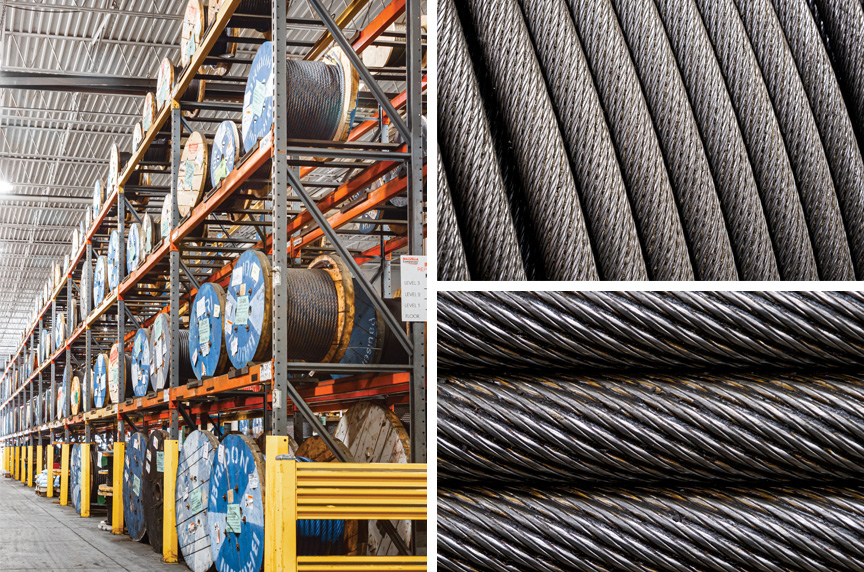When you’re selecting the right kind of Wire Rope, you have to think about a bunch of stuff to make sure you get the best performance and safety and you get the longest life out of the rope. For example, there are 7 things about wire rope, design characteristics to help you select the wire rope to give you the best safety and service life for your wire rope:
- Strength
- Fatigue Resistance
- Bend ability
- Crushing Resistance
- Metal Loss & Deformation Resistance
- Rotation Resistance
- Corrosion Resistance
No wire rope has all of these characteristics. In fact, when a wire rope scores high in one category, it typically scores low in another category. Therefore, you have to be really careful when you’re evaluating wire rope. Ultimately, you want to select a wire rope that gives up the least important benefits as opposed to the most important ones. Given that trade-off, it’s important to prioritize the characteristics that are most important for your specific application, whether it’s for crane hoist rope or shock loading wire rope. Understanding these nuances will help you select a wire rope that best matches your operational needs and safety requirements.
For a deeper dive into these considerations, you can refer to properties to consider before purchasing a wire rope.
When you’re thinking about strength, think about the potential workload. Are you going to have dynamic loads caused by abrupt acceleration, shock loads, sudden stops, dead weight, and high speeds.
Anything that sends a shockwave through the rope causes vibration fatigue. Because this energy must be absorbed and since absorption takes place at different points along the rope, choose the right product based on the shockwave type. When a wire rope is repeatedly bent, it begins to fatigue to the point of eventual failure preceded by telltale broken wires. For that reason, consider the diameter of the rope wires, smaller wires tend to give longer bending fatigue life. Fatigue can also be reduced by using larger diameter sheaves and drums.
With crushing, external pressure applied to the rope, causing distortion to the cross-section. At that point, the rope can no longer move and adjust as it should. Larger outer wires and strand & rope compacting make for a more crush resistant, stable wire rope.
Think about resistance to metal loss and deformation when selecting a wire rope. Of the conditions deemed destructive to wire rope, this is the very common. Although this often happens at the sheaves and drums, it can also occur when the rope rubs against itself or an object. Eventually, the rope wears, making it inoperable and unsafe. Larger outside wires and compaction of rope or strands will last longer than smaller, non-compacted wire ropes & strands when resisting metal loss and deformation. In applications like wire rope for crane operations, where the rope frequently contacts pulleys and lifting mechanisms, this resistance becomes even more crucial to prevent premature wear and tear. Ensuring a high safety factor in these ropes is key to maintaining operational integrity and preventing unexpected failures due to metal loss and deformation.
A wire rope used as a crane hoist line, single part or multi part, where rotation resistance is important, there are many rotation resistant wire ropes to choose from. This factor is particularly vital in hoisting wire ropes where consistent performance and load stability are key during lifting operations. Ranking from the least Resistant to Rotation, 19×7 or 19×19. If these don’t satisfy your rotation issue, 35×7 class wire ropes are the most Rotation Resistant commonly available and should solve most any Rotation problems.
If you need the wire rope to go around some relatively small sheaves and drums, you’ll need a wire rope that is more bendable. Not flexible, bendable. A wire rope with small outer diameter wires will be more bendable than one with larger outer wires.
Standard Bright wire ropes are not very resistant to corrosion. The only protection they have is a fairly thin layer of lubricant/corrosion preventative to keep them from corroding. If you need more protection, you can first try heavy, often applied lubrication. Next, to reduce corrosion, Drawn Galvanized wire rope is available in most sizes and constructions. Drawn Galvanizing allows the wire rope to be equal in strength to a Non Galvanized wire rope of the same construction and diameter. If you need more corrosion resistance, Stainless Steel wire rope is available, at a lower strength for equal size and construction. The most common choice is Type 302/304 SS. For more Corrosion Resistance consider Type 316 Stainless Steel. For extreme conditions other exotics are available in limited sizes – Monel & Inconel are two.



